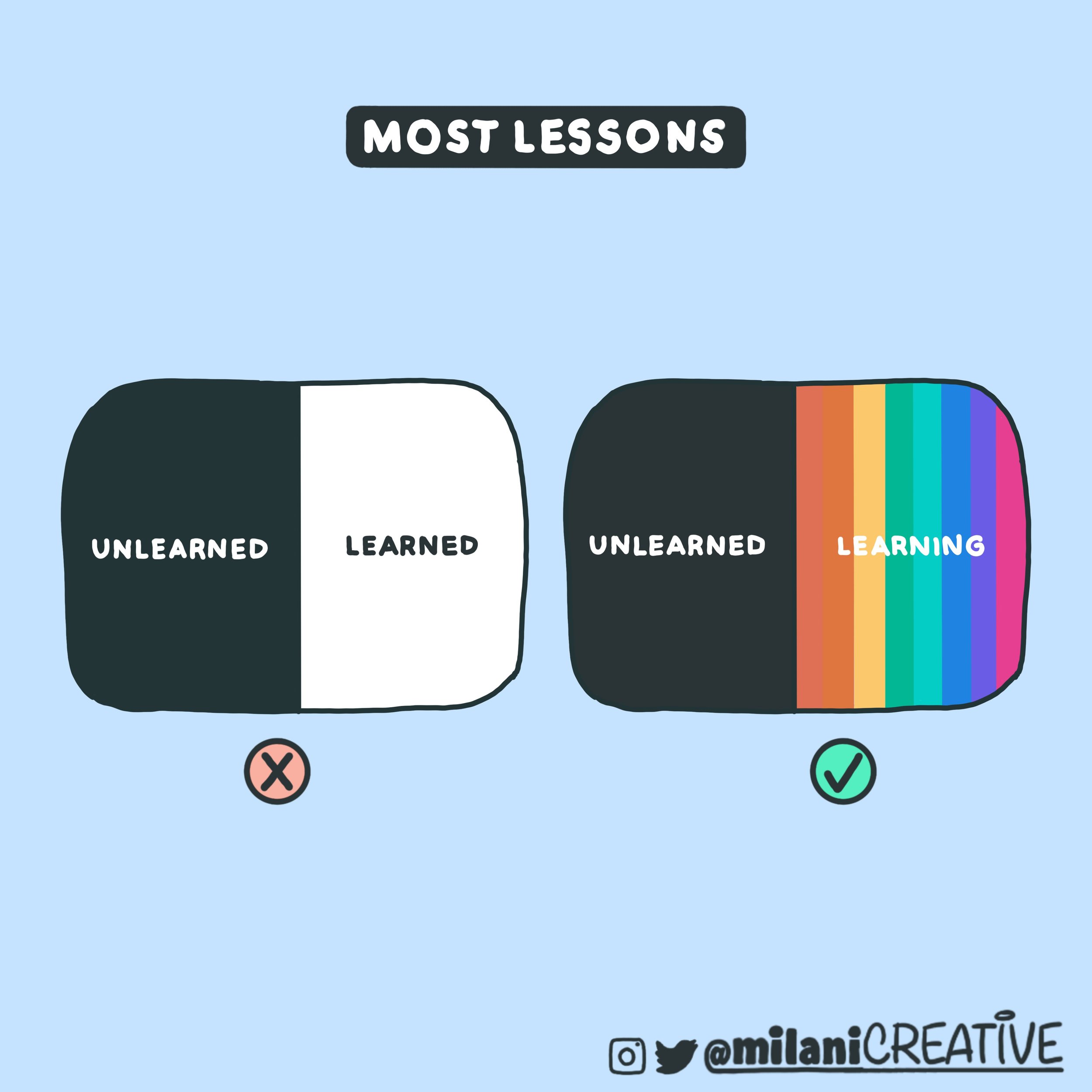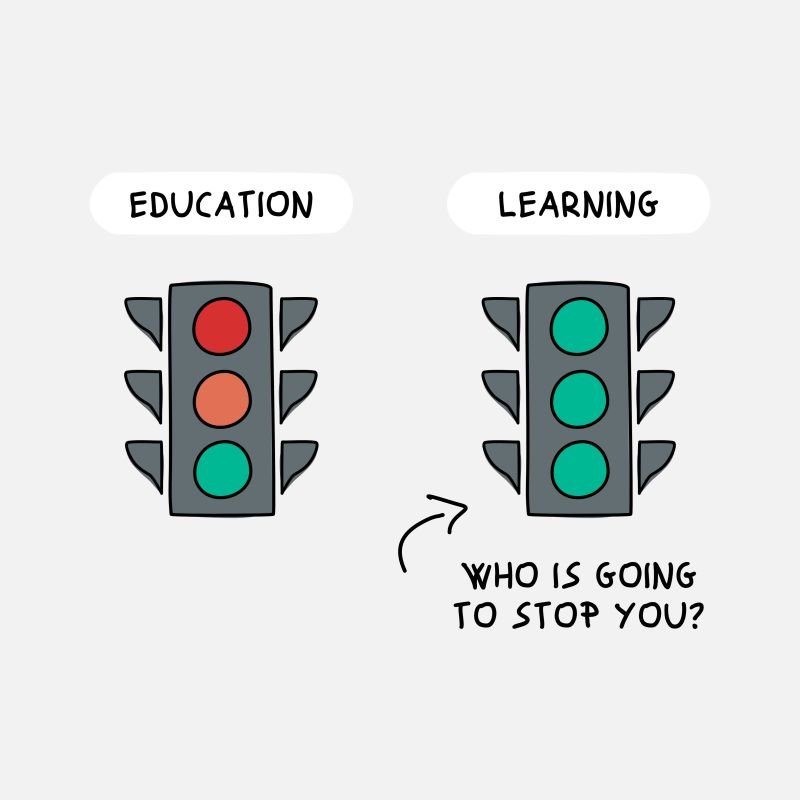Learning Nerd’s Diary #45
Welcome back Learning Nerds!
👀 Sneak peak
Here is what I have in store for you this week -
💭 Learning About Learning: 5 Lessons that Changed the Way I Design Courses
🥜 Learning Nugget: Cupcakes vs Pancakes
🧠 Learning Heuristics: No.08 Minimum Viable Learning Experiences
💥 Coolest Thing I Learnt This Week:
The Learning Spectrum
Education vs Learning
Hello, I’m… Learning
🔦 Spotlight: Building Learning Charters
Let's jump right in!
💭 5 Lessons that Changed the Way I Design Courses
Last week I finished the Course Design Accelerator by Dr. Phillipa Hardman. Staying true to ‘Learning by teaching’ this article is an attempt at capturing some of the many learnings I’ve had over the 3 weeks course.
Here are 5 Lessons that changed the way I design courses:
1/ Shifting from 80-10-10 → 10-80-10
🚫 Mistake
As learning experience designers we tend to focus a lot on content. Most courses look something like this:
80% Content
10% Activities
10% Feedback
This approach leads to information overload for the learner often resulting in drop-offs and don’t contribute to the mastery of the topic.
✅ Solution
Instead we need to design courses where we have:
10% Content
80% Activities
10% Feedback
This is called the Minimum Viable Content Framework. By shifting the focus from passive content to hands-on activities for the learner - they are more engaged and can progress towards mastering the topic.
2/ Discovery → Outcome → Storytelling
🚫 Mistake
More often than not we start designing learning experiences by starting with the how. We start storyboarding and start thinking about how the content needs to be designed, how the live session needs to be delivery and so on.
By starting with the how, we end up being blindsided in the decision making process - with a poor understanding of our learners & their context.
✅ Solution
Instead we should approach the course design process like:
Discovery - starting with the why for our learners
Outcomes - mapping the what or the topics we’re covering
Storyboarding - detailing out the how i.e. content, activities and feedback
By going through this structured process, we’re able to tap into the learner’s motivations and design courses where we champion the needs of the learner.
3/ Instruction << Feedback
🚫 Mistake
Courses we design often focus primarily on instruction - things the facilitator will be ‘teaching’. And while there is a lot learners can learn from experts in the domain, instruction is often not the best use of their time with the learner.
✅ Solution
The best use of instructor time is actually to give for feedback. Feedback can come in different shape & sizes:
Telling you what you did right and where you can improve
What good and bad outputs look like
Showcasing how the instructor would have approached the problem
Seeing what my peers have done
By focussing on feedback - you also tend to prioritise the learner actively doing something rather than them just being passive.
4/ Communication is key
🚫 Mistake
As course designers we often undermine the power that good packaging and branding has. From the name of the course and modules to the design of the landing pages to the visuals used in the content - communication contributes to the overall learning experience.
✅ Solution
Human beings are very visceral. Words, colours, framing - all matter. We need to be able to communicate effectively with our learners. And this requires us to pay attention to the details and iterate on it over time. These could include:
The name of the course, module, concept
The way the learning outcomes are framed for a module
The visuals used in the content
5/ Go Meta
🚫 Mistake
Most courses purely focus on the subject matter at hand. We try to get learners to understand only the concept deeply without getting them to connect the concept to the real world or their prior knowledge or who they are as individuals.
✅ Solution
As course designers - we need to create opportunities for your learners to zoom out and go meta. Now reflection can have many faces but here are a few things you can ask your learners to do:
Articulate their intentions - ask them why
Connect it to something that they knew in the past
Think how they approached solving a problem
These 5 lessons among many others has started changing my practice right away! Which one resonated with you the most? Tell me!
🥜 Cupcakes vs Pancakes
Learning is not a cupcake but a pancake.
Cupcakes need to go into a mould to define them, pancakes are content being misshapen and different.
🧠 #8: Minimum Viable Learning Experiences
Aesthetic and minimalist design→ Minimum Viable Learning Experiences
Learning Experiences are mostly designed to be maximalist. We think - “Let’s add this video and that article and that framework - because why not?” But when it comes to learning experiences, less is more.
Great learning experiences are not ones that give you all the answers, but ones that give you enough support to find your own answers.
Some tips:
Think of what is the one thing that you’re doing that adds the most delta to your learner
With everything that you add in a learning experience, think of 2 things that you can remove to take its place
💥 Coolest Thing I Learnt this Week
The Learning Spectrum
I came across this Tweet by Wes Kao this week:
Learning a lesson isn’t always binary. Sometimes it’s a spectrum. I’ve been thinking about the idea of “learned this—and still learning it.” It’s powerful because some lessons are learned, finished, locked in. But many times, you understand it AND are still learning it.
Education vs Learning
I love this so much!
Hello, I’m… learning
Incase you needed to hear this today…
🔦 Spotlight
A sneak peak into a session I did last week for the Learning Festival on Building a Learning Charter. So much fun!
Love & Learning
Until we meet next week!
Will hit you back next Monday!
You can get this directly in your inbox!








